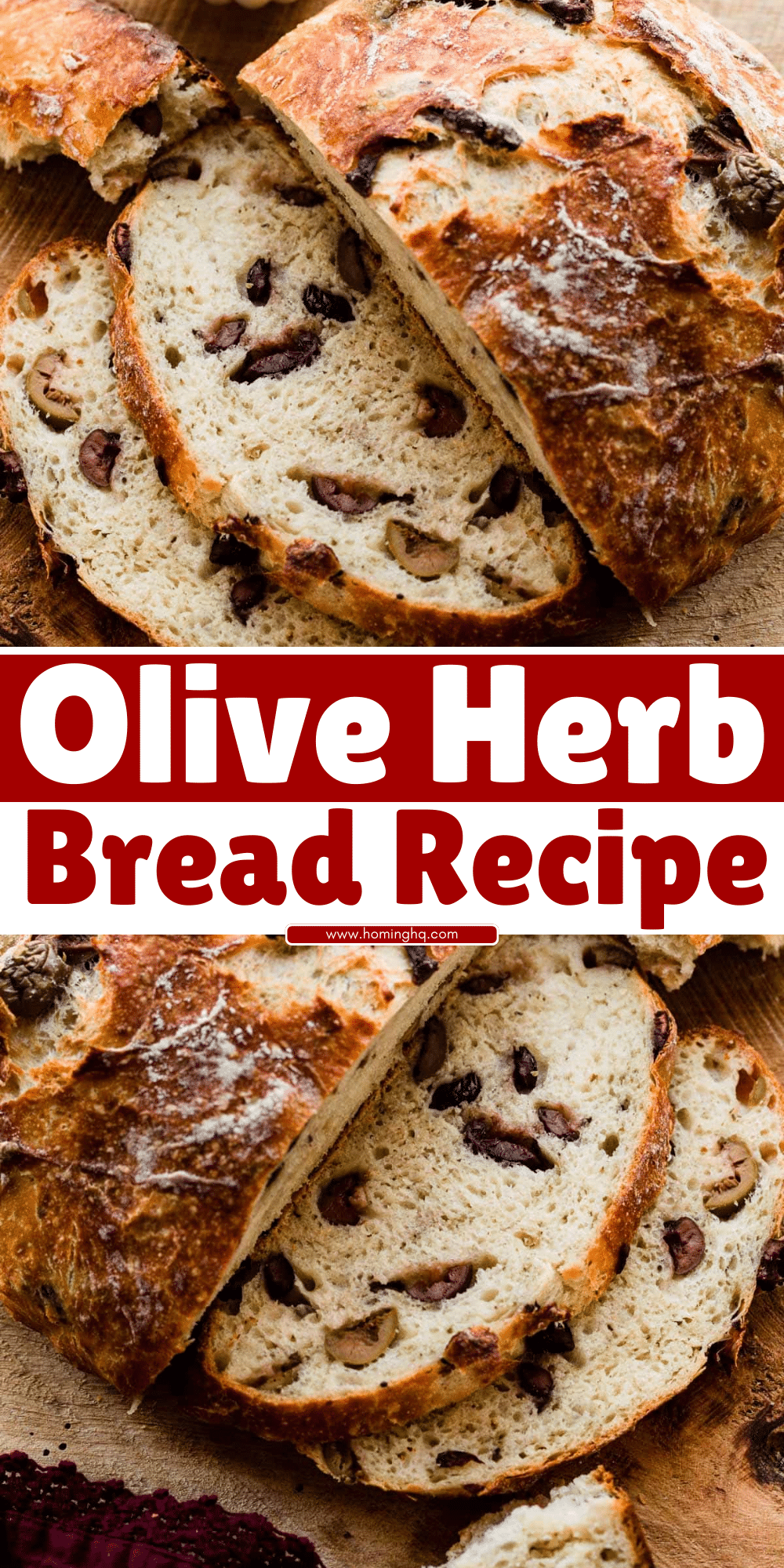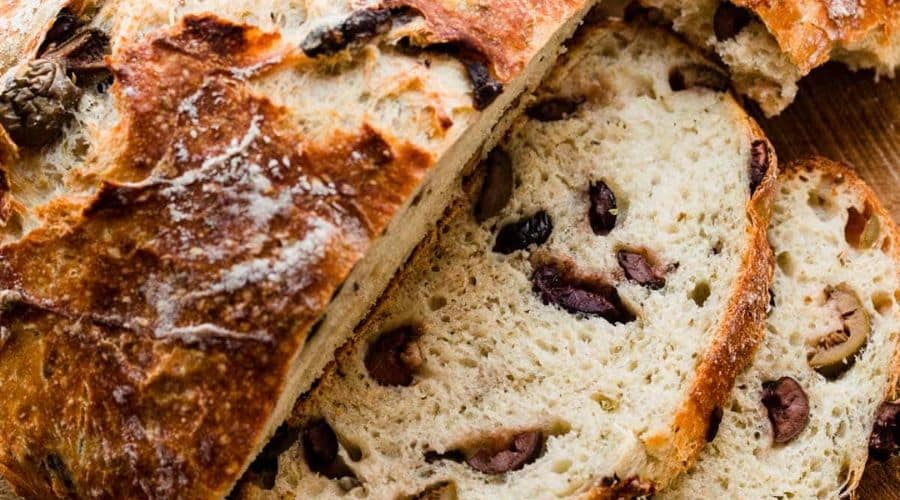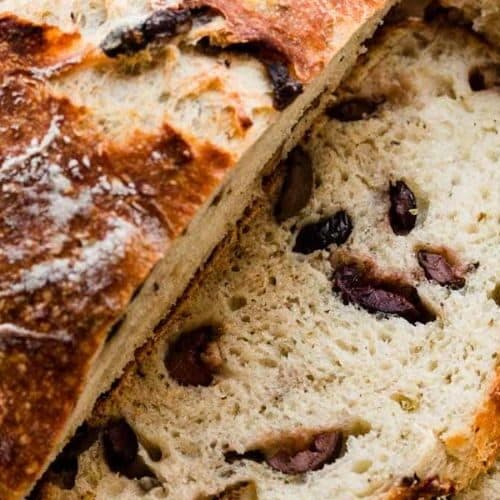All products are selected by our editorial team for quality. If you buy through our links, we may earn a small commission at no extra cost to you.
Olive Herb Bread is a flavorful and aromatic bread that combines the richness of olive oil with a delightful blend of fresh herbs.
Whether served as an appetizer, a side dish, or part of a gourmet meal, this bread offers a delicious twist on traditional bread recipes.
The combination of savory herbs and the natural richness of olives makes it a perfect complement to a wide range of dishes.
Its versatility and inviting aroma make Olive Herb Bread a favorite among bread lovers.

What is Olive Herb Bread?
Olive Herb Bread is a type of artisanal bread made with high-quality olives and aromatic herbs such as rosemary, thyme, and oregano.
The olives add a savory, briny depth, while the herbs infuse the bread with a fragrant, earthy flavor.
Often baked to a golden brown crust, this bread has a soft, tender crumb inside.
The addition of olive oil ensures that the bread remains moist and adds a subtle richness to every bite.
It’s a perfect bread to enjoy on its own, dipped in olive oil or paired with cheese, salads, or soups.
Key Ingredients for Olive Herb Bread
- Olive Oil
Olive oil is a cornerstone ingredient in this recipe, contributing to the bread’s moist texture and enhancing its flavor with a smooth, slightly fruity taste. - Olives
Either green or black olives can be used, depending on your preference. Chopped olives provide bursts of briny, tangy flavor that complement the herbs beautifully. - Flour
The base of the bread, typically all-purpose or bread flour, gives structure and helps the dough rise perfectly. - Fresh Herbs
Common herbs include rosemary, thyme, and oregano, which bring a fresh, fragrant aroma and deep herbal notes to the bread. - Yeast
Essential for helping the dough rise and achieve its airy texture, yeast is key in giving the bread its light, fluffy crumb. - Water
Water helps activate the yeast and binds the dry ingredients into a dough. - Salt
Salt enhances all the flavors in the bread, balancing the richness of the olive oil and the brininess of the olives.
Equipment You’ll Need to Make Olive Herb Bread
To make Olive Herb Bread, you’ll need a few basic kitchen tools that will help you shape, mix, and bake the bread to perfection.
Here’s a list of the essential equipment:
1. Mixing Bowl
A large mixing bowl is essential for combining your dry and wet ingredients and kneading the dough.
You’ll need enough room for the dough to rise during the proving stage.
2. Wooden Spoon or Dough Hook
A wooden spoon is perfect for stirring the ingredients together.
Alternatively, a stand mixer with a dough hook attachment can be used for hands-free kneading.
3. Measuring Cups and Spoons
Accurate measurements are key to making a successful loaf of bread.
Make sure you have both dry and liquid measuring cups for precise amounts of ingredients.
4. Baking Sheet or Loaf Pan
If you’re baking a rustic round loaf, a baking sheet will do the job.
If you prefer a more uniform shape, a loaf pan is recommended.
5. Parchment Paper
For easy cleanup and to prevent sticking, lining your baking sheet or loaf pan with parchment paper is a must.
6. Clean Kitchen Towel or Plastic Wrap
You’ll need something to cover the dough while it rises.
A kitchen towel or plastic wrap will help the dough retain moisture during the proving process.
7. Sharp Knife or Razor Blade
For scoring the bread before baking, a sharp knife or a razor blade is used to make decorative cuts on the top of the dough.
Step-by-Step Instructions to Make Olive Herb Bread

Now that you’re equipped with the necessary tools, follow these simple steps to create your own homemade Olive Herb Bread.
Step 1: Prepare the Dough
In a large mixing bowl, combine the flour, salt, and yeast.
Stir gently to mix. In a separate bowl, mix together the warm water and olive oil, then pour it into the dry ingredients.
Use a wooden spoon or your hands to bring the dough together, forming a rough ball.
Step 2: Add Olives and Herbs
Once the dough starts to come together, add the chopped olives and herbs.
Continue kneading the dough on a floured surface for about 8-10 minutes, until it’s smooth and elastic.
If you’re using a stand mixer, let the dough hook work on medium speed for 5-7 minutes.
Step 3: First Rise
Place the kneaded dough in a lightly greased bowl, then cover it with a clean kitchen towel or plastic wrap.
Let it rise in a warm place for about 1 to 1.5 hours, or until it doubles in size.
This is your dough’s first rise, where it will become light and airy.
Step 4: Shape the Dough
Once the dough has risen, punch it down to release the air bubbles.
Gently shape the dough into a round loaf or form it into a rectangular shape if you’re using a loaf pan.
If you prefer, you can also divide the dough into smaller rolls.
Step 5: Second Rise
Place the shaped dough on a baking sheet lined with parchment paper.
Cover it once again and let it rise for another 30-45 minutes, or until it has puffed up slightly.
Step 6: Preheat the Oven
Preheat your oven to 375°F (190°C). While it heats up, score the top of the dough with a sharp knife or razor blade to allow it to expand beautifully while baking.
Step 7: Bake the Bread
Place the dough in the preheated oven and bake for 25-30 minutes, or until the bread turns golden brown and sounds hollow when tapped on the bottom.
If you’re baking smaller rolls, check them after about 15-18 minutes.
Step 8: Cool and Serve
Remove the bread from the oven and let it cool on a wire rack for at least 15 minutes before slicing.
This resting time allows the flavors to develop and the texture to set.
Conclusion
Olive Herb Bread is a wonderful addition to any meal, offering a unique balance of flavors with its savory olives and fragrant herbs.
Its simple yet flavorful ingredients make it a versatile option for various occasions, from casual dinners to special gatherings.
Whether served fresh from the oven or toasted with a drizzle of olive oil, this bread never fails to impress.
With just a few essential ingredients and easy-to-follow steps, you can enjoy homemade Olive Herb Bread that rivals any bakery version.
So, gather your ingredients, get baking, and savor the delightful aroma of this herb-infused bread.
Frequently Asked Questions
1. Can I use different herbs in Olive Herb Bread?
Yes! While rosemary, thyme, and oregano are traditional choices, you can experiment with other herbs like basil, sage, or marjoram for a unique twist.
Fresh or dried herbs will work well in this recipe.
2. How can I store Olive Herb Bread?
Store your Olive Herb Bread in an airtight container or wrap it in a clean kitchen towel.
It will stay fresh for 2-3 days at room temperature.
For longer storage, you can freeze it by wrapping the bread tightly in plastic wrap and placing it in a freezer bag for up to 3 months.
3. Can I make this bread without olives?
Yes, you can omit the olives if you prefer a simpler herb bread.
You can also substitute olives with sun-dried tomatoes or even cheese for a different flavor profile.
4. Is there a gluten-free version of Olive Herb Bread?
You can make a gluten-free version by using gluten-free flour blends.
Keep in mind that the texture may be slightly different, so you may need to adjust the amount of liquid and yeast.
5. Can I use store-bought olives?
Absolutely! While fresh, pitted olives are ideal, store-bought olives can work just as well.
Be sure to chop them into small pieces to evenly distribute the flavor throughout the dough.

Olive Herb Bread
Equipment
- Mixing Bowl – 1 large (for combining ingredients)
- Wooden Spoon – 1 (for stirring dough)
- Measuring Cups and Spoons – 1 set (for precise ingredient amounts)
- Stand Mixer with Dough Hook – 1 (optional, for easier kneading)
- Baking Sheet – 1 (for baking the bread)
- Loaf Pan – 1 (optional, for a loaf shape)
- Parchment Paper – 1 sheet (for lining the baking surface)
- Clean Kitchen Towel or Plastic Wrap – 1 (for covering the dough during rises)
- Sharp Knife or Razor Blade – 1 (for scoring the bread before baking)
Ingredients
- 3 ½ cups 440g – All-purpose flour
- 2 teaspoons 10g – Active dry yeast
- 1 ½ teaspoons 7g – Salt
- 1 cup 240ml – Warm water
- ¼ cup 60ml – Olive oil
- ¾ cup 100g – Chopped olives (green or black)
- 1 tablespoon 2g – Fresh rosemary (chopped)
- 1 tablespoon 2g – Fresh thyme (chopped)
- 1 tablespoon 2g – Fresh oregano (chopped)
Instructions
Prepare the Dough
- In a large mixing bowl, combine the flour, salt, and yeast. Stir together. In a separate bowl, combine the warm water and olive oil, then pour into the dry ingredients. Stir with a wooden spoon until a rough dough forms.
Add Olives and Herbs
- Once the dough begins to come together, fold in the chopped olives and fresh herbs. Knead the dough on a floured surface for 8-10 minutes until it’s smooth and elastic. Alternatively, use a stand mixer with a dough hook on medium speed for 5-7 minutes.
First Rise
- Place the dough in a greased bowl, cover it with a clean kitchen towel or plastic wrap, and let it rise in a warm place for 1 to 1.5 hours, or until it doubles in size.
Shape the Dough
- Punch down the dough and shape it into a round loaf or a loaf shape if using a loaf pan. Place it on a parchment-lined baking sheet (or into the loaf pan).
Second Rise
- Cover the dough and let it rise for another 30-45 minutes, until it has puffed up.
Preheat the Oven
- Preheat the oven to 375°F (190°C). While it heats, score the top of the dough with a sharp knife to create decorative slashes.
Bake the Bread
- Bake the dough in the preheated oven for 25-30 minutes, or until the bread sounds hollow when tapped on the bottom and is golden brown. Smaller rolls will bake in about 15-18 minutes.
Cool and Serve
- Remove the bread from the oven and let it cool on a wire rack for at least 15 minutes before slicing and serving.
Notes
- Flavor Variations: Feel free to switch up the herbs based on what you have on hand. Basil, sage, or marjoram are excellent additions.
- Storage: Store the bread in an airtight container at room temperature for up to 3 days. Alternatively, you can freeze it for up to 3 months by wrapping it tightly in plastic wrap and placing it in a freezer bag.
- Olive Options: Green olives have a milder flavor, while black olives are slightly more robust. Choose your favorite or mix both!
- For a Crustier Bread: If you like a crispier crust, you can place a shallow pan of water at the bottom of the oven while baking to create steam.

